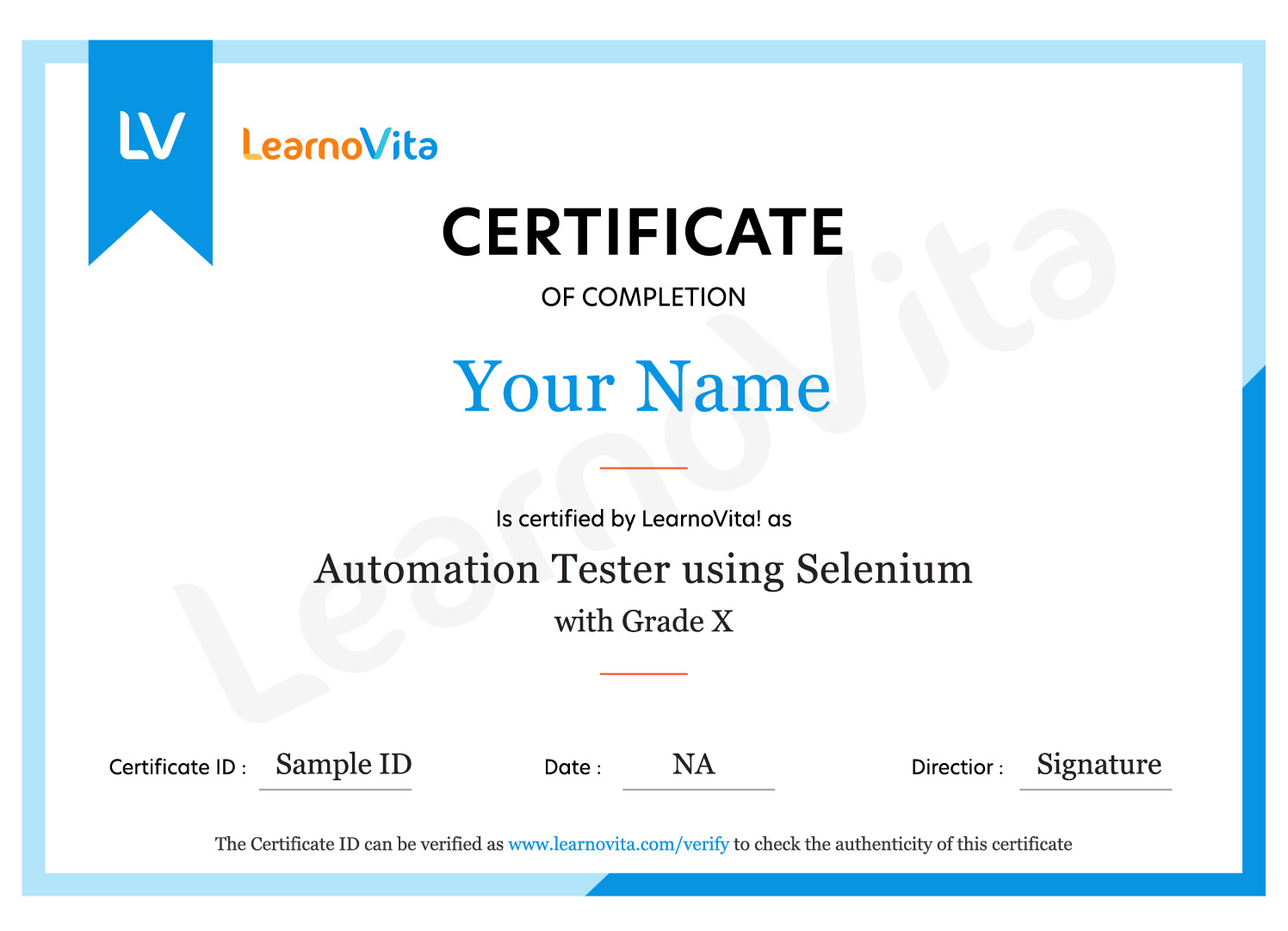Online Classroom Batches Preferred
Weekdays Regular
(Class 1Hr - 1:30Hrs) / Per Session
Weekdays Regular
(Class 1Hr - 1:30Hrs) / Per Session
Weekend Regular
(Class 3hr - 3:30Hrs) / Per Session
Weekend Fasttrack
(Class 4:30Hr - 5:00Hrs) / Per Session
No Interest Financing start at ₹ 5000 / month
Top Skills You Will Gain
- Core Java
- J2EE , Struts
- Spring, Servlets
- Hibernate, JDBC
- Web Services
- Advanced Java
- EJB, JDO, JSF
- Android Development
Java Course Key Features 100% Money Back Guarantee
-

5 Weeks Training
For Become a Expert -

Certificate of Training
From Industry Java Experts -

Beginner Friendly
No Prior Knowledge Required -

Build 3+ Projects
For Hands-on Practices -

Lifetime Access
To Self-placed Learning -

Placement Assistance
To Build Your Career
Top Companies Placement
- Designation
-
Annual SalaryHiring Companies
Java Course Curriculam
Trainers Profile
Java Trainers gives the required individual attention to each student and provides in-depth training with complete hands-on practices . Trainers are certified professionals with 9+ years of experience and they are currently working with Top MNCs. LearnoVita Instructors trains the students with Industry-relevant skills .
Pre-requisites
Prerequisite You must know at least the basics of how to use a computer, and should be able to start a command line shell. If you are new to programming then Introduction to Programming is strongly recommended.
Syllabus of Java Course in OMR Download syllabus
- Features of Java
- Simple
- Secure
- Portable
- Robust
- Multithreading
- Platform-Independent
- Distributed.
- Dynamic
- New Features of Java 8
- Introducing Java Environment
- Java Development Kit
- Java Platforms
- Java Virtual Machine
- Java API
- Java Programs
- Installing Java
- What about CLASSPATH?
- Java’s Reserve Words
- Starting a Java program
- Line 1—public class App
- Line 2—public static void main(String[] args)
- Line 3—System.out.println(“Hello from Java!”);
- Compiling Code 15
- Compiling Code: Using Command-Line Options
- Cross-Compilation Options
- Compiling Code: Checking for Deprecated Methods
- Running Code
- Running Code: Using Command-Line Options
- Commenting Your Code
- Importing Java Packages and Classes
- Finding Java Class with CLASSPATH
- Summary
- Variables
- Data Typing
- Arrays
- Strings
- What Data Types are Available?
- Creating Integer Literals
- Creating Floating-Point Literals
- Creating Boolean Literals
- Creating CharLearnoVitar Literals
- Creating String Literals
- Creating Binary Literals
- Using Underscores in Numeric Literals
- Declaring Integer Variables
- Declaring Floating-Point Variables
- Declaring CharLearnoVitar Variables
- Declaring Boolean Variables
- Initializing Variables Dynamically
- Conversion between Data Types
- Automatic Conversions
- Casting to New Data Types
- Declaring One-Dimensional
- Creating One-Dimensional Arrays
- Initializing One-Dimensional Arrays
- Declaring Multi-Dimensional Arrays
- Creating Multi-Dimensional Arrays
- Initializing Multi-Dimensional Arrays
- Creating Irregular Multi-Dimensional Arrays
- Getting an the Length of an Array
- Understanding General Form of Static Import
- Importing Static Members
- The String Class
- Getting String Length
- Concatenating Strings
- Getting CharLearnoVitars and Substrings
- Searching For and Replacing Strings
- Changing Case in Strings
- Checking for Empty String
- Formatting Numbers in Strings
- The StringBuffer Class
- Creating StringBuffers
- Getting and Setting StringBuffer Lengths and Capacities
- Setting CharLearnoVitars in String Buffers
- Appending and Inserting Using StringBuffers
- Deleting Text in StringBuffers
- Replacing Text in String Buffer
- Using the Wrapper Class
- Autoboxing and Unboxing of Primitive Types
- Learning the Fundamentals of Varargs Methods
- Overloading Varargs Methods
- Learning the Ambiguity in Varargs Methods
- Using Non-Reifiable Formal Parameters
- Operators
- Conditionals
- Loops
- Operator Precedence
- Incrementing and Decrementing (++ and --)
- Unary NOT (~ And !)
- Multiplication and Division (* and /)
- Modulus (%)
- Addition and Subtraction (+ and -)
- Shift Operators (>>, >>>, and <<)
- Relational Operators (>, >=, <, <=, ==, and !=)
- Bitwise and Bitwise Logical AND, XOR, and OR (&, ^, and /)
- Logical (&& and ||)
- The if-then-else Operator
- Assignment Operators (= and [operator]=)
- Using the Math
- Changes in the Math Class
- Class StrictMath
- Comparing Strings
- The if Statement
- The else Statement
- Nested if
- The if-else Ladders
- The switch Statement
- Using Strings in switch Statement
- The while Loop
- The do-while Loop
- The for Loop
- The for-each Loop
- Supporting for-each in Your Own Class
- A (Poor) Solution
- Significance of for-
- Nested Loops
- Using the break Statement
- Using the continue Statement
- Using the return Statement
- Summary
- The Control Overview of a Class
- Working with Objects
- Working with Methods
- Defining Default Methods
- Working with Constructors
- Using Default Constructor
- Using Parameterized Constructors
- Exploring Packages
- Studying the Types of Packages
- Importing Packages
- Using Access Specifiers
- Working with Streams API
- Stream API Overview
- Collection and Stream
- Commonly Used Functional Interfaces in Stream
- Java.util.Optional
- Aggregate Operations
- Working with Time API
- Understanding Encapsulation
- Understanding Abstraction
- Understanding Inheritance
- Understanding the final Keyword
- Preventing Inheritance
- Declaring Constant
- Preventing Method Overriding
- Implementing Interfaces
- Working with Lambda Expressions
- Method References
- Using Lambda Expressions
- Implementing Abstract Classes and Methods
- Difference between Abstract Classes and Interfaces
- Implementing Polymorphism
- Understanding the Static Polymorphism
- Understanding the Dynamic Polymorphism
- Summary
- Streams, Readers and Writers
- Essentials in NIO
- Buffers
- Channels
- Charsets and Selectors
- Enhancements in NIO with Java 8
- The Path Interface
- The Files Class
- The Paths Class
- The File Attribute Interfaces
- The FileSystem Class
- The FileSystems Class
- The FileStore Class
- Prospects of NIO
- Working with Streams
- The InputStream Class
- The OutputStream Class
- The ByteArrayInputStream Class
- The ByteArrayOutputStream Class
- The BufferedInputStream Class
- The BufferedOutputStream Class
- The FileInputStream Class
- The FileOutputStream Class
- Working with the Reader Class
- Working with the Writer Class
- Accepting Input from the Keyboard with the InputStreamReader Class
- Working with the OutputStreamWriter Class
- Working with Files
- Using the File Class
- Using the FileReader Class
- Using the FileWriter Class
- Working with the RandomAccessFile Class
- Working with CharLearnoVitar Arrays
- Using the CharArrayReader Class
- Using the CharArrayWriter Class
- Working with Buffers
- Using the BufferedReader Class
- Using the BufferedWriter Class
- Working with the PushbackReader Class
- Working with the PrintWriter Class
- Working with the StreamTokenizer Class
- Implementing the Serializable Interface
- Working with the Console Class
- Working with the Clipboard
- Working with the Printer
- Printing with the Formatter Class
- Using the System.out.printf() Method
- Using the String.format() Method
- Formatting Dates Using the String.format() Method
- Using the Java.util.Formatter Class
- Scanning Input with the Scanner class
- Summary
- Exception Handling Techniques
- Rethrowing Catched Exception with Improved Type Checking
- Built-in Exceptions
- User-Defined Exceptions
- Summary
- Using Threads in Java
- Life Cycle of a Thread
- Synchronization of Threads
- Multithreaded Custom Class Loader
- Getting the Main Thread
- Naming a Thread
- Pausing a Thread
- Creating a Thread with the Runnable Interface
- Creating a Thread with the Thread Class
- Creating Multiple Threads
- Joining Threads
- Checking if a Thread Is Alive
- Setting Thread Priority and Stopping Threads
- Synchronizing
- Communicating between Threads
- Suspending and Resuming Threads
- Creating Graphics Animation with Threads
- Eliminating Flicker in Graphics Animation Created Using Threads
- Suspending and Resuming Graphics Animation
- Using Double Buffering
- Simplifying Producer-Consumer with the Queue Interface
- Implementing Concurrent Programming
- Simplifying Servers Using the Concurrency Utilities
- Knowing Various Concurrency Utilities
- Learning about the Java.util.concurrent Package
- Learning about the Java.util.concurrent.locks Package
- Learning about the Java.util.concurrent.atomic Package
- Summary
- The Collection Interfaces
- The Collection Classes
- The Map Interfaces
- The Map Classes
- Collections Framework Enhancements in Java SE 8
- Using the Collection Interface
- The Queue Interface
- The List Interface
- The Set Interface
- The SortedSet Interface
- Using the Collection Classes
- Using the Comparator Interface
- Using the Iterator Interface
- Using the ListIterator Interface
- Using the AbstractMap Class
- Using the HashMap Class
- Using the TreeMap Class
- Using the Arrays Class
- Learning the Fundamentals of Enumerations
- The Legacy Classes and Interfaces
- Using the Aggregate Operations
- Using the Java.util.function Package
- Summary
- Packages and Interfaces
- JAR Files
- The Java API Package
- The Java.lang Package
- Basics of Annotation
- Other Built-In Annotations
- Creating a Package
- Creating Packages that have Subpackages
- Creating an Interface
- Implementing an Interface
- Extending an Interface
- Using Interfaces for Callbacks
- Performing Operations on a JAR File
- Marker Annotations
- Single Member Annotations
- Summary
- What is Java Bean?
- Advantages of Java Bean
- Introspection
- Persistence
- Customizers
- Understanding Java Beans
- Designing Programs Using Java Beans
- Creating Applets that Use Java Beans
- Creating a Java Bean
- Creating a Bean Manifest File
- Creating a Bean JAR File
- Creating a New Bean
- Adding Controls to Beans
- Giving a Bean Properties
- Design Patterns for Properties
- Using Simple Properties
- Designing Patterns for Events
- Learning Methods and Design Patterns
- Creating Bound Properties
- Giving a Bean Methods
- Giving a Bean an Icon
- Creating a BeanInfo Class
- Setting Bound and Constrained Properties
- Implementing Persistence
- Using the Java Beans API
- Learning the Basics of an Event
- Using the Java Beans Conventions
- Using the Remote Notification and Distributed Notification
- Using Beans with JSP
- Summary
- Basics of Networking
- Sockets in Java
- Client-Server Networking
- Proxy Servers
- Internet Addressing
- Domain Name Service
- Inet4Addresses and Inet6Addresses
- The URL Class
- The URI Class
- URI Syntax and Components
- TCP/IP and Datagram
- Blackboard Assignment Retrieval Transaction
- Understanding Networking Interfaces and Classes in the Java.net Package
- Understanding the InetAddresses
- Caching InetAddress
- Creating and Using Sockets
- Creating TCP Clients and Servers
- Understanding the Whois Example
- Submitting an HTML Form from a Java Program
- Handling URL
- Using the URLConnection Objects
- Working with Datagrams
- Datagrams Server and Client
- Working with BART
- Learning about the Java.security Package
- Summary
- Introducing Events
- Introducing Event Handling
- Working with the Types of Servlet Events
- Developing the onlineshop Web Application
- Introducing Wrappers
- Working with Wrappers
- Summary
- Introducing JSP Technology
- Listing Advantages of JSP over Java Servlet
- Exploring the Architecture of a JSP Page
- Describing the Life Cycle of a JSP Page
- Working with JSP Basic Tags and Implicit Objects
- Working with Action Tags in JSP
- Exploring EL
- Using Custom Tag Library with EL Functions
- Exploring the Need of Filters
- Exploring the Working of Filters
- Exploring Filter API
- Configuring a Filter
- Creating a Web Application Using Filters
- Using Initializing Parameter in Filters
- Manipulating Responses
- Discussing Issues in Using Threads with Filters
- Summary
- Describing the Java EE Application Architecture
- Introducing a Design Pattern
- Discussing the Role of Design Patterns
- Exploring Types of Patterns
- Summary
- Section A: Exploring SOA and Java Web Services
- Overview of SOA
- Describing the SOA Environment
- Overview of JWS
- Role of WSDL, SOAP and Java/XML Mapping in SOA
- Section B: Understanding Web Service Specifications to Implement SOA
- Exploring the JAX-WS 2.2 Specification
- Exploring the JAXB 2.2 Specification
- Exploring the WSEE 1.3 Specification
- Exploring the WS-Metadata 2.2 Specification
- Describing the SAAJ 1.3 Specification
- Working with SAAJ and DOM APIs
- Describing the JAXR Specification
- JAXR Architecture
- Exploring the StAX 1.0 Specification
- Exploring the WebSocket 1.0 Specification
- Describing the JAX-RS 2.0 Specification
- Exploring the JASON-P 1.0 Specification
- Section C: Using the Web Service Specifications
- Using the JAX-WS 2.2 Specification
- Using the JAXB 2.2 Specification
- Using the WSEE and WS-Metadata Specifications
- Implementing the SAAJ Specification
- Implementing the JAXR Specification
- Implementing the StAX Specification
- Introduction to Hibernate
- Hibernate CRUD Operation
- Hibernate Queries and Relationships
- Mapping Relationship with Hibernate
- Introduction to Spring
- Dependency Injection, SpringBean Lifecycle, Wiring and Scope
- Introduction to Spring AOP (Aspect-Oriented Programming)
- Configuring AOP in Java Application using AspectJ Approach
- Spring JDBC Implementation in an Application
- Spring Hibernate Template
- Spring JDBC Transaction Management
- Spring MVC Architecture, Components, and Framework
- Spring MVC Program
Contact Us
+91 9176954999
(24/7 Support)
Request for Information
Industry Projects
Mock Interviews
- Mock interviews by Learnovita give you the platform to prepare, practice and experience the real-life job interview. Familiarizing yourself with the interview environment beforehand in a relaxed and stress-free environment gives you an edge over your peers.
- In our mock interviews will be conducted by industry best Java Training in OMR experts with an average experience of 7+ years. So you’re sure to improve your chances of getting hired!
How Learnovita Mock Interview Works?
Java Training Objectives
- Java can be explained as an object-oriented programming language that executes the job of coding for developers and programmers easier. It can be used to build applications and install them in a cross-platform context. Java technology is the most widely used software platform today whether it be client-side or server-side.
- It is an Open Source Platform. It offers an easy to access application programming interface which is supported on multiple platforms and permits you to generate reusable codes which is an independent platform that supports garbage collection. It can automate memory management. Also can be used to build dynamic web applications has powerful developmental tools. Start Enhance Your Career with Advance Java Training in OMR
- There is no doubt that Java programming is one of the highest paying jobs in the business right now, and is in great question. A job portal, Indeed, has the most job postings for Java skills as compared to several other computer languages, with over 36,000 listings for programmers with outstanding Java programming skills.
- For many years now, universities have raised their computer science curriculum which has presented some of the best Java developers around the globe. With such a wide talent of Java developer being in such high need, advanced Java skills can set you apart from the pool of average Java developers out there. it is a skill that could make or break your job search.
- A Java developer is a specialized type of programmer who may collaborate with web developers and software engineers to integrate Java into business applications, software, and websites, which makes another reason for the demand for java developers in this digital era.
- Certainly Yes. Even the recruiters know the knowledge we get in colleges is not enough to do a software job. They will see how confident you are. However they will train you according to their requirement once you get into the company.
- Be confident with your basics that's enough You to get tons of Jobs opportunity by learning Java programming language from Java Coaching Centers in OMR.
- The Core JAVA training on OMR is adequate to get me a decent job. We can practice according to our course and apply them very easily in our career.
- You get trained with real-time projects.
- You get opportunities to get engaged and discuss with your heads.
- The future scope of JAVA Programmer in India is great as its salary in India is at the most. These technologies are among the highest paid jobs in the IT industry, especially in Chennai.
- There is a huge Market entry to various countries and jobs in major corporations.
- Join immediately in job opportunities after Completion of Advance Java Course in OMR.
- Active Coordination with students are taken care of so that they would get proper guidance throughout the course procedure.
- Preliminary Preparation assures that our students can perform positively in Interviews alike if it is their First Interview.
- In most case, you don't exactly need an associate degree in web design which is the most common requirement that we here. you just need an urge to learn more. but some basic skills like C, C++... etc, add up to ur career and learning process.
- Having Active Thinking is enough to Understand the JAVA Concepts. The Basic Programing Language of C and C++ language knowledge is Just to make Ease to Understand the Concepts Easily.
- To discover why Java is useful for desktop and web applications.
- To learn how to achieve object-oriented designs with Java.
- To identify Java language elements and how they work mutually in applications.
- To design and process stand-alone Java applications.
- Design Applets using Swing, AWT and GUI applications
- Develop Networking and Multithreaded applications
- Develop database applications using JDBC
- Software developers
- Web designers
- Programming enthusiasts
- Engineering graduates
- Students who all want to become Java developers
- This is in no way an inferior way to showcase your skills but to build your career as a Java developer, you need to be out of the box. You require to put your designs into action preferably than just settling them up away.
- The professionals shining in Java can choose for a Career in Big Data, as Hadoop, the most successful Big Data architecture framework, practices Java in its designing and development.
- An average Java developer salary in India is Rs 443,568 per annum approximately or an hourly pay of Rs. 175.00 as per research.
Exam & Certification
Java Online Training / Class Room:
- Participate and Complete One batch of Java Training Course
- Successful completion and evaluation of any one of the given projects
- Complete 85% of the Java Certification Training
- Successful completion and evaluation of any one of the given projects
- Oracle Certified Associate (OCA)
- Oracle Certified Professional (OCP)
- Oracle Certified Expert (OCE)
- Oracle Certified Master (OCM)
- Learn About the Certification Paths.
- Write Code Daily This will help you develop Coding Reading and Writing ability.
- Refer and Read Recommended Books Depending on Which Exam you are Going to Take up.
- Join LernoVita Java Certification Training in OMR That Gives you a High Chance to interact with your Subject Expert Instructors and fellow Aspirants Preparing for Certifications.
- Solve Sample Tests that would help you to Increase the Speed needed for attempting the exam and also helps for Agile Thinking.

Recently placedstudents
Pranav Srinivas
Software Testing, CapgeminiJava Course FAQ's
- LearnoVita Best Java Training in OMR will assist the job seekers to Seek, Connect & Succeed and delight the employers with the perfect candidates.
- On Successfully Completing a Career Course from LearnoVita Best Java Course in OMR, you Could be Eligible for Job Placement Assistance.
- 100% Placement Assistance* - We have strong relationship with over 650+ Top MNCs, When a student completes his/ her course successfully, LearnoVita Placement Cell helps him/ her interview with Major Companies like Oracle, HP, Wipro, Accenture, Google, IBM, Tech Mahindra, Amazon, CTS, TCS, HCL, Infosys, MindTree and MPhasis etc...
- LearnoVita is the Legend in offering placement to the students. Please visit our Placed Students's List on our website.
- More than 5400+ students placed in last year in India & Globally.
- LearnoVita is the Best Java Training Institute in OMR Offers mock interviews, presentation skills to prepare students to face a challenging interview situation with ease.
- 85% percent placement record
- Our Placement Cell support you till you get placed in better MNC
- Please Visit Your Student's Portal | Here FREE Lifetime Online Student Portal help you to access the Job Openings, Study Materials, Videos, Recorded Section & Top MNC interview Questions
- LearnoVita Certification is Accredited by all major Global Companies around the World.
- LearnoVita is the unique Authorized Oracle Partner, Authorized Microsoft Partner, Authorized Pearson Vue Exam Center, Authorized PSI Exam Center, Authorized Partner Of AWS and National Institute of Education (nie) Singapore
- Also, LearnoVita Technical Experts Help's People Who Want to Clear the National Authorized Certificate in Specialized IT Domain.
- LearnoVita is offering you the most updated java certification training in OMR, relevant, and high-value real-world projects as part of the training program.
- All training comes with multiple projects that thoroughly test your skills, learning, and practical knowledge, making you completely industry-ready.
- You will work on highly exciting projects in the domains of high technology, ecommerce, marketing, sales, networking, banking, insurance, etc.
- After completing the projects successfully, your skills will be equal to 6 months of rigorous industry experience.
- We will reschedule the java classes in OMR as per your convenience within the stipulated course duration with all such possibilities.
- View the class presentation and recordings that are available for online viewing.
- You can attend the missed session, in any other live batch.













